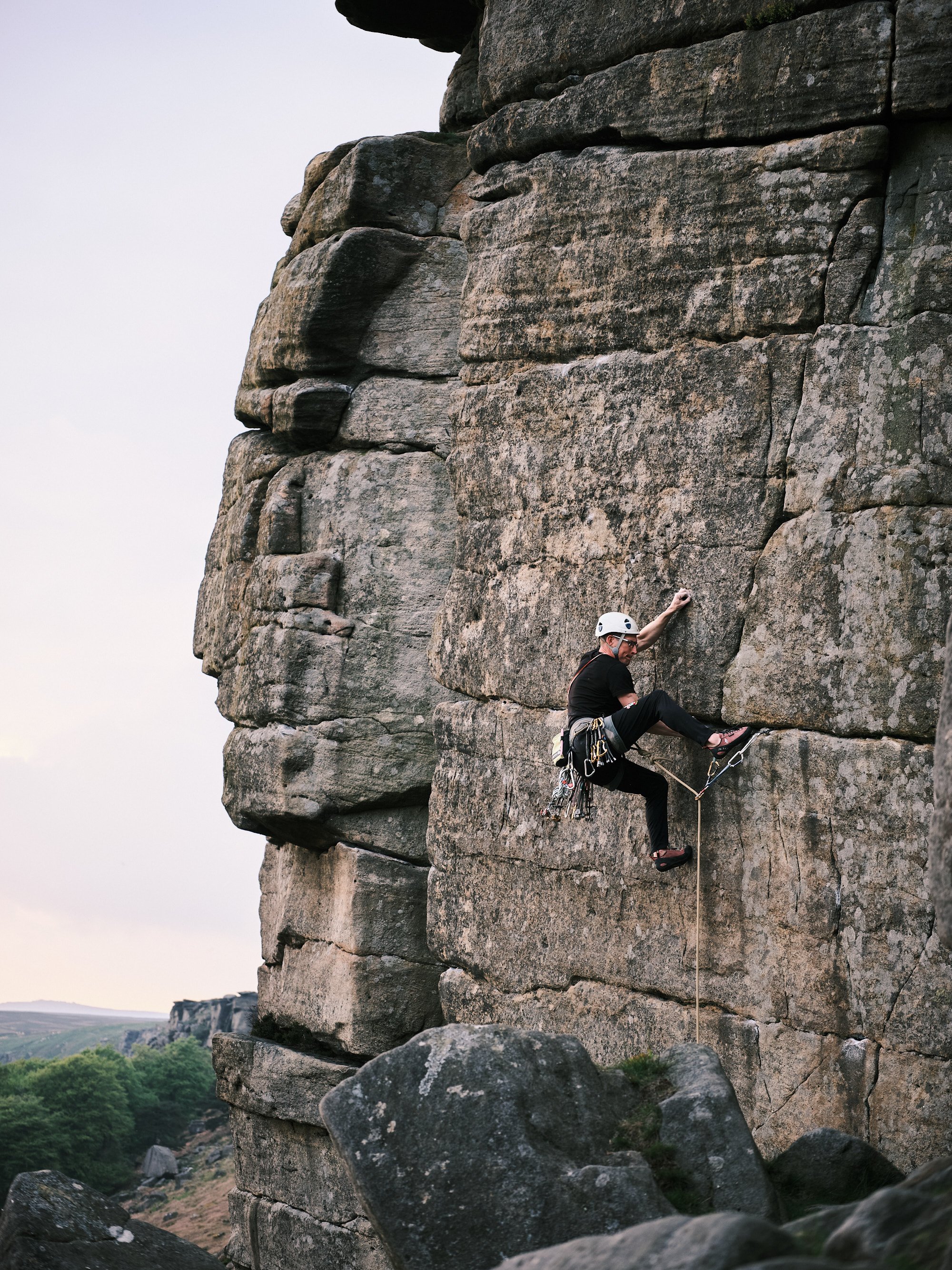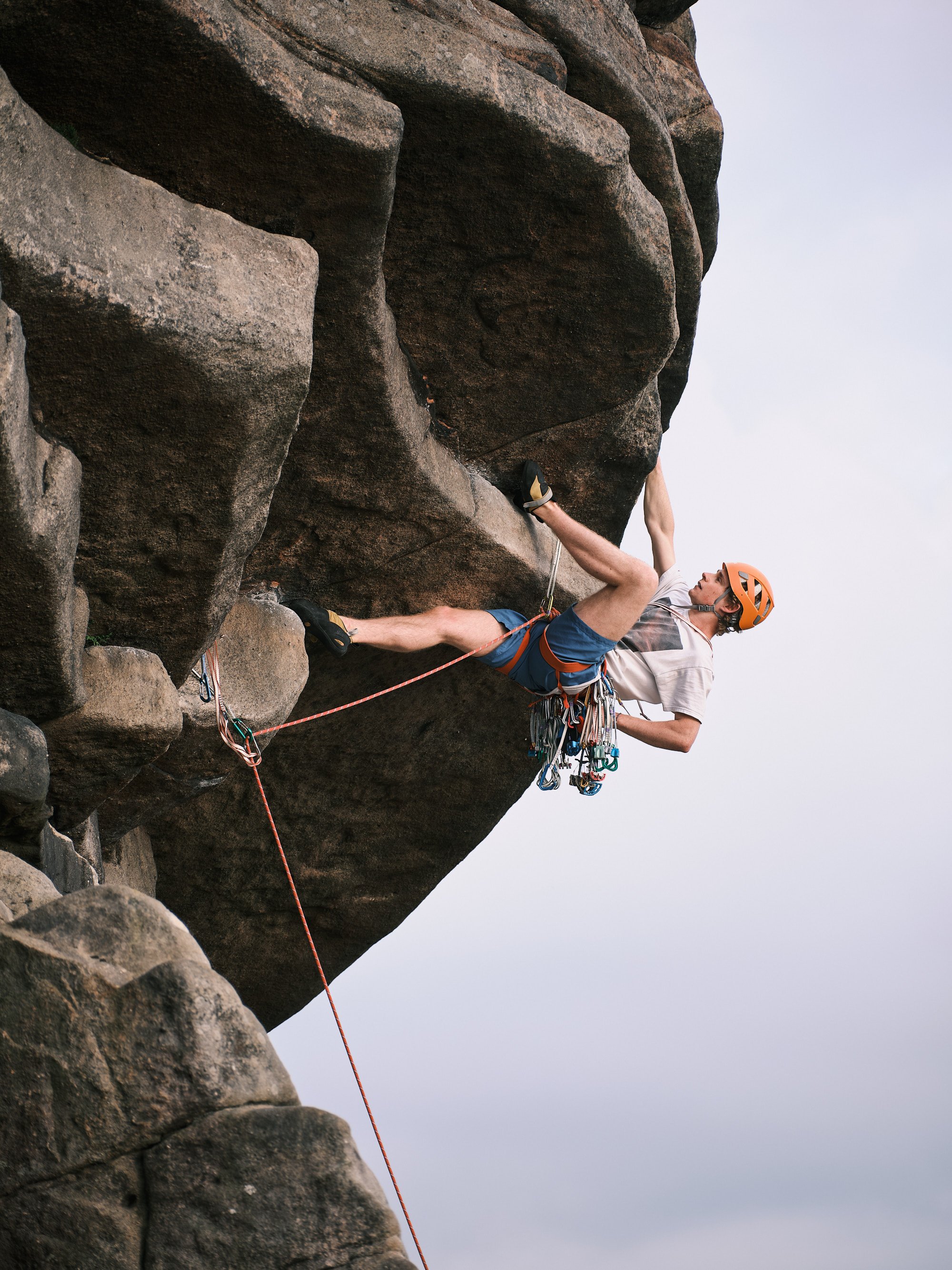Pennine Lines w/c 22 May 2023
|| Warm, dry, pleasant || Cool enough in the wind ||
Fingers In Every Pie Start || Climber: Adam Coefield
|| Focus On ||
Access
This week I’ve returned from the Isle of Skye to find that climbers’ access to one of the Churnet’s finest crags, Wright’s Rock in Staffordshire, has been completely removed. Anyone following this development can’t have failed to notice the accompanying handwringing and gnashing of teeth online on the state of climbers’ disrespectful behaviour; the fact the Churnet apparently gets busy with climbers up from London, or that everyone climbs stuff when it’s damp, or that the rock and crags here simply can’t cope with this level of traffic.
Now don’t get me wrong, I’d usually be at the front of the queue to slag off climbers coming up from That London but we would do well to step back and take a longer look at the situation before sticking the boot in to our fellow climbers. Does anyone actually know the proportion of climbers or climber visits which were breaching the access rules at Wright’s? No, nobody knows that, likely not even the landowner. Do we know where the climbers were coming from? No. Do we know if they are fresh out of the indoor walls with a don’t-give-a-toss attitude, or loyal locals with a strong emotional connection to the place? No, we don’t know that either. Do we know if they missed the signs, did they not care, or did they just object a decades-old access precedent being suddenly rescinded? We can only guess, and meanwhile the pile-on continues.
It’s certainly true that poor behaviour occurs in the Churnet, as it does everywhere. In fact the last time I visited Wright’s we arrived to find the entire crag condensed and soaking wet, so we drove straight back to Sheffield, meanwhile a team of lads from Nottingham rather than London were there happily climbing on the damp rock with their bluetooth speaker blaring out.
It’s also true that, yes, bouldering has gotten more popular, and yes, the Churnet rock is particularly vulnerable to damage, particularly when damp. And yes, climbing walls and brands profiting from increased participation are, for the most part, doing little or nothing to provide proper mentorship for new climbers making the leap to the outdoors. But this isn’t about climbing on damp rock or leaving tick marks, it’s just about us climbers having the temerity to be there are all.
Peakstone Inn Amphitheatre || Climber: Chris Taylor
Rather depressingly you don’t have to look far to see a lot of buy-in to the narrative that we’ve lost access due to poor behaviour. In fact the UKC news headline rather uncritically proclaims - “New Access Ban at Wright's Rock due to Rule-Breaking Climbers”. But whose rules are they, and why were they imposed in the first place?
Wright’s Rock is a crag which has seen continuous free and open access, as far as I am aware, going back at least as far as the earliest recorded routes there in the late 1950s. Since then it’s grown in importance to be one of the marquee crags of the Churnet, with some of the best rock in the area, a great set of problems, good landings, a pleasant open aspect, and often stays dry in light rain. It’s a busy and important crag in this part of the world, and as such it’s cemented its place in the hearts of many climbers both local and those travelling from further afield. Then what’s happened is some money has changed hands, a different person’s name is on the deeds to the land, and suddenly that single individual has decided they essentially want the place to themselves; to directly quote the landowner “reserved for both our paying guests, friends, us and the wildlife”. Hence the curtain is being drawn shut on 60-odd years of climbing history.
The recently imposed rules only permitted access on Fri-Sun (potentially the busiest days of the week), no later than 5pm (arguable the best time to climb during summer months), and no more than 6 people at once, a number which for a crag of the size and status of Wright’s is as close to zero as makes no odds. And of course the number of people climbing is impossible to ascertain until you’re actually at the crag, by which time you look like you’ve already broken the rules if 6 people got there first. As far as I can tell these rules were brought in without much (if any?) consultation with users, and were simply in response to the owners presumably not wanting climbers present.
Can a landowner legally do this? Yes. Morally speaking, should they unilaterally remove access to an outdoor space with a long history of sustained recreational use and an important place in the culture and history of users? It’s hard to agree that this is anything other than disastrously naive land management practice, and for this reason alone the restrictions were always doomed to fail, aside from the clumsy nature of the rules themselves. Is the loss of access primarily down to “rule breaking climbers” or is it fundamentally because the landowner basically would rather not have climbers there? Rules imposed on users - who are human beings and hence by definition flawed, make it inevitable that at some point those rules will be broken, and hey presto access is removed. Job done. Whichever way you look at it the Wright’s situation was never going to be sustainable in the long term and it represents a complete failure to properly engage existing user groups as much as it represents a failure of climbers to ‘behave’ and stay in our lane.
Cottage Rocks || Climber: John Coefield
Speaking as someone with Scotland fresh in my mind it’s interesting to compare the Wright’s situation to that north of the border, where “responsible non-motorised access for recreational and other purposes” to land and the countryside is guaranteed by law, specifically the Land Reform (Scotland) Act 2003. People will be quick to point out that the social and geographic landscape of Scotland is very different to that of England and Wales, but in reality it’s not all that different to much of the upland and coastal areas down here, where most of the climbing lies.
Since there’s no suggestion that the ‘bad behaviour’ of climbers at Wright’s amounts to anything other than simply being there then we should note that if Wright’s were in Scotland there would be no legal grounds at all to restrict access. So I think instead of enjoying the pile-on and readily buying into this climbers = evil self-defeating narrative we’d do better to organise and advocate against unreasonable or unworkable access restrictions. As a representative body Mountaineering Scotland played a key role in the establishment of the Land Reform (Scotland) Act 2003 and similarly the BMC can and should play an equally important part in improving access in England and Wales.
|| Kinder Scout, scene of the 1932 Mass Trespass ||
So what can we do? Well, I would encourage everyone to take an active interest in access issues wherever you are. Be responsible, behave in the right way but don’t be walked over. Don’t just tug our forelocks and accept whatever crumbs we are thrown from the table. Doffing of caps to the tiny minority who own the deeds to our open spaces did not win our right of access; it was events like the Kinder Mass Trespass that did that. Find your local BMC area meetings, attend them if you can, and be vocal about your legal and moral rights to access the countryside and open spaces for recreation. And that includes when you exercise your democratic rights at the ballot box, as the current political climate in England and Wales would have to change if we are ever to obtain parity with Scotland. Remember that what local access rights we do have in England and Wales had to be fought for and can easily be lost if we’re caught sleeping on these issues.
|| Recently through the lens ||
Warm weather is with us, as are the midges, but this doesn't stop the Stanage midweek evening teams.
|| Fresh Prints ||
As it starts to warm up here's a couple of images to help remember those crisp frosty mornings in the Print Shop.








